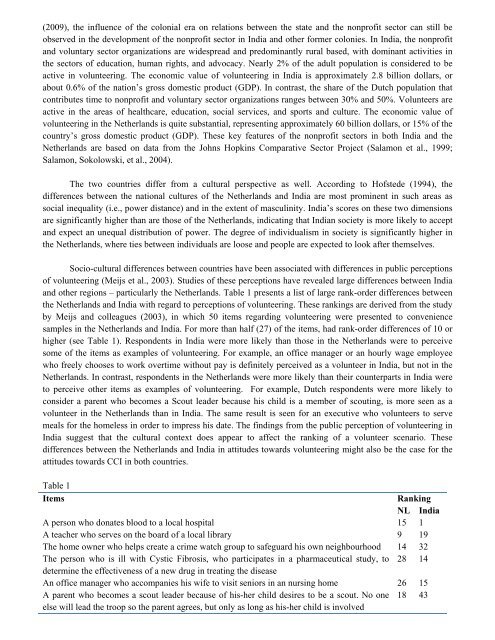hoofdstuk%20boek%20nitte%20def
hoofdstuk%20boek%20nitte%20def
hoofdstuk%20boek%20nitte%20def
Create successful ePaper yourself
Turn your PDF publications into a flip-book with our unique Google optimized e-Paper software.
(2009), the influence of the colonial era on relations between the state and the nonprofit sector can still be<br />
observed in the development of the nonprofit sector in India and other former colonies. In India, the nonprofit<br />
and voluntary sector organizations are widespread and predominantly rural based, with dominant activities in<br />
the sectors of education, human rights, and advocacy. Nearly 2% of the adult population is considered to be<br />
active in volunteering. The economic value of volunteering in India is approximately 2.8 billion dollars, or<br />
about 0.6% of the nation’s gross domestic product (GDP). In contrast, the share of the Dutch population that<br />
contributes time to nonprofit and voluntary sector organizations ranges between 30% and 50%. Volunteers are<br />
active in the areas of healthcare, education, social services, and sports and culture. The economic value of<br />
volunteering in the Netherlands is quite substantial, representing approximately 60 billion dollars, or 15% of the<br />
country’s gross domestic product (GDP). These key features of the nonprofit sectors in both India and the<br />
Netherlands are based on data from the Johns Hopkins Comparative Sector Project (Salamon et al., 1999;<br />
Salamon, Sokolowski, et al., 2004).<br />
The two countries differ from a cultural perspective as well. According to Hofstede (1994), the<br />
differences between the national cultures of the Netherlands and India are most prominent in such areas as<br />
social inequality (i.e., power distance) and in the extent of masculinity. India’s scores on these two dimensions<br />
are significantly higher than are those of the Netherlands, indicating that Indian society is more likely to accept<br />
and expect an unequal distribution of power. The degree of individualism in society is significantly higher in<br />
the Netherlands, where ties between individuals are loose and people are expected to look after themselves.<br />
Socio-cultural differences between countries have been associated with differences in public perceptions<br />
of volunteering (Meijs et al., 2003). Studies of these perceptions have revealed large differences between India<br />
and other regions – particularly the Netherlands. Table 1 presents a list of large rank-order differences between<br />
the Netherlands and India with regard to perceptions of volunteering. These rankings are derived from the study<br />
by Meijs and colleagues (2003), in which 50 items regarding volunteering were presented to convenience<br />
samples in the Netherlands and India. For more than half (27) of the items, had rank-order differences of 10 or<br />
higher (see Table 1). Respondents in India were more likely than those in the Netherlands were to perceive<br />
some of the items as examples of volunteering. For example, an office manager or an hourly wage employee<br />
who freely chooses to work overtime without pay is definitely perceived as a volunteer in India, but not in the<br />
Netherlands. In contrast, respondents in the Netherlands were more likely than their counterparts in India were<br />
to perceive other items as examples of volunteering. For example, Dutch respondents were more likely to<br />
consider a parent who becomes a Scout leader because his child is a member of scouting, is more seen as a<br />
volunteer in the Netherlands than in India. The same result is seen for an executive who volunteers to serve<br />
meals for the homeless in order to impress his date. The findings from the public perception of volunteering in<br />
India suggest that the cultural context does appear to affect the ranking of a volunteer scenario. These<br />
differences between the Netherlands and India in attitudes towards volunteering might also be the case for the<br />
attitudes towards CCI in both countries.<br />
Table 1<br />
Items Ranking<br />
NL India<br />
A person who donates blood to a local hospital 15 1<br />
A teacher who serves on the board of a local library 9 19<br />
The home owner who helps create a crime watch group to safeguard his own neighbourhood 14 32<br />
The person who is ill with Cystic Fibrosis, who participates in a pharmaceutical study, to 28<br />
determine the effectiveness of a new drug in treating the disease<br />
14<br />
An office manager who accompanies his wife to visit seniors in an nursing home 26 15<br />
A parent who becomes a scout leader because of his-her child desires to be a scout. No one<br />
else will lead the troop so the parent agrees, but only as long as his-her child is involved<br />
18 43



